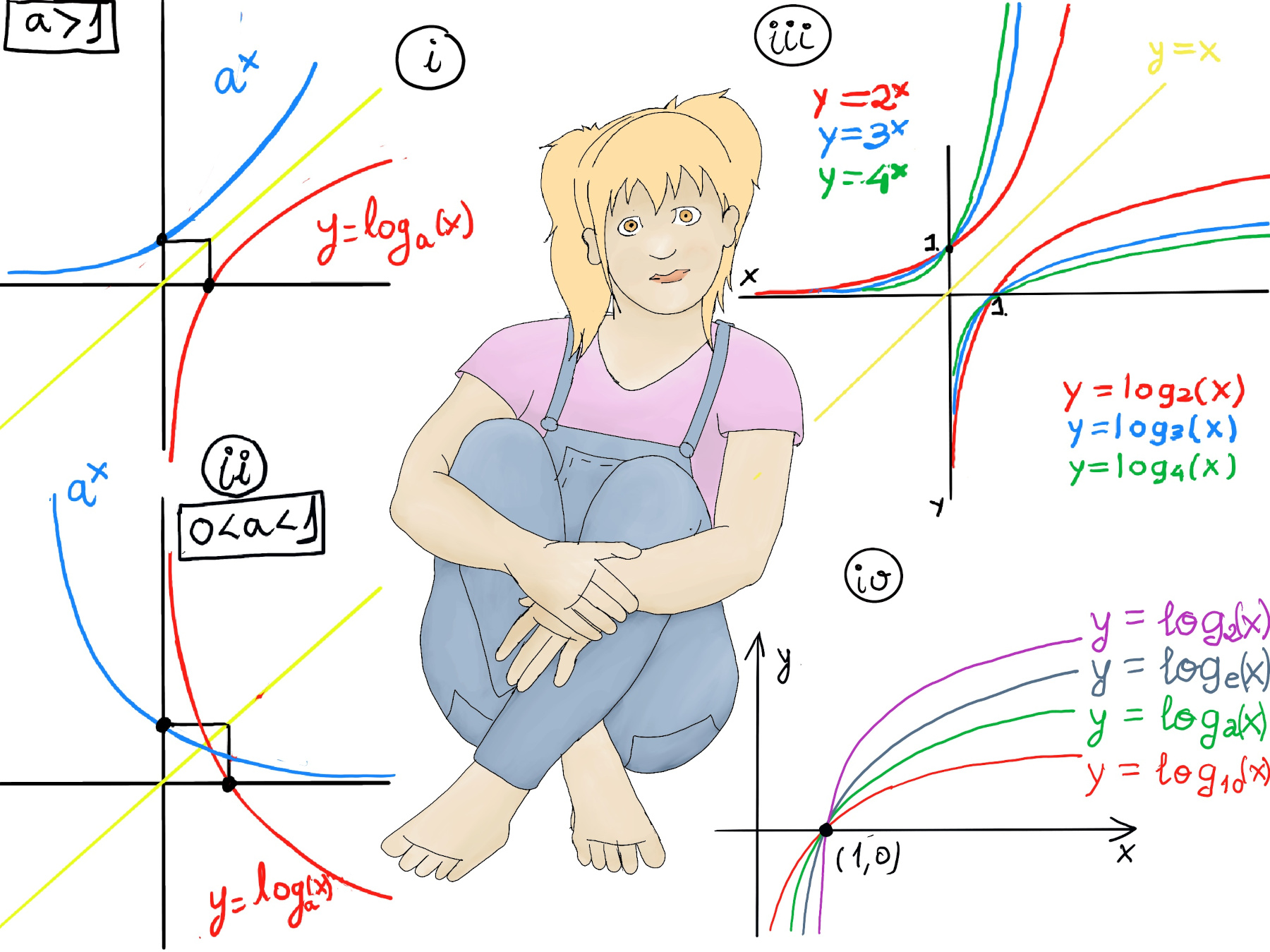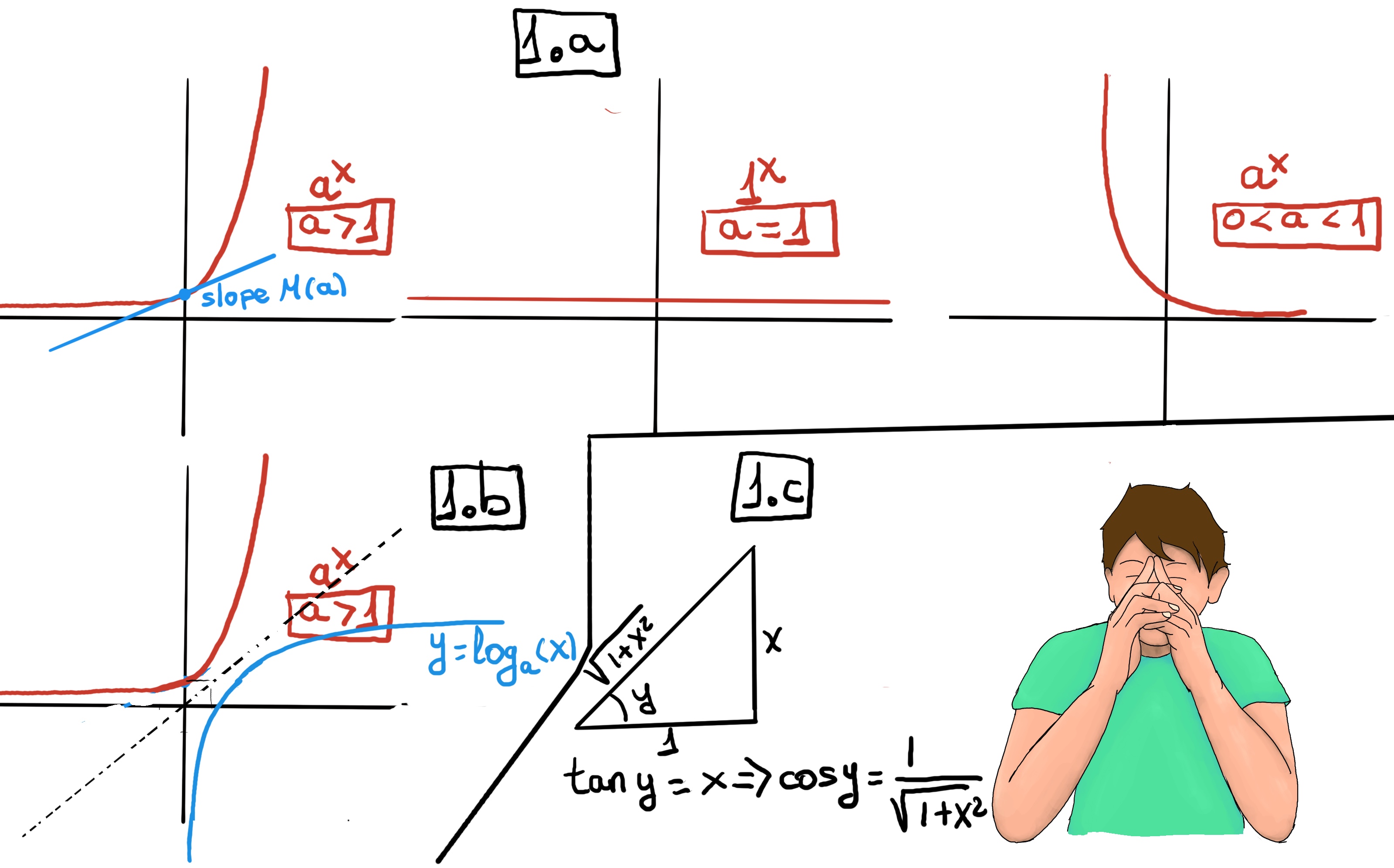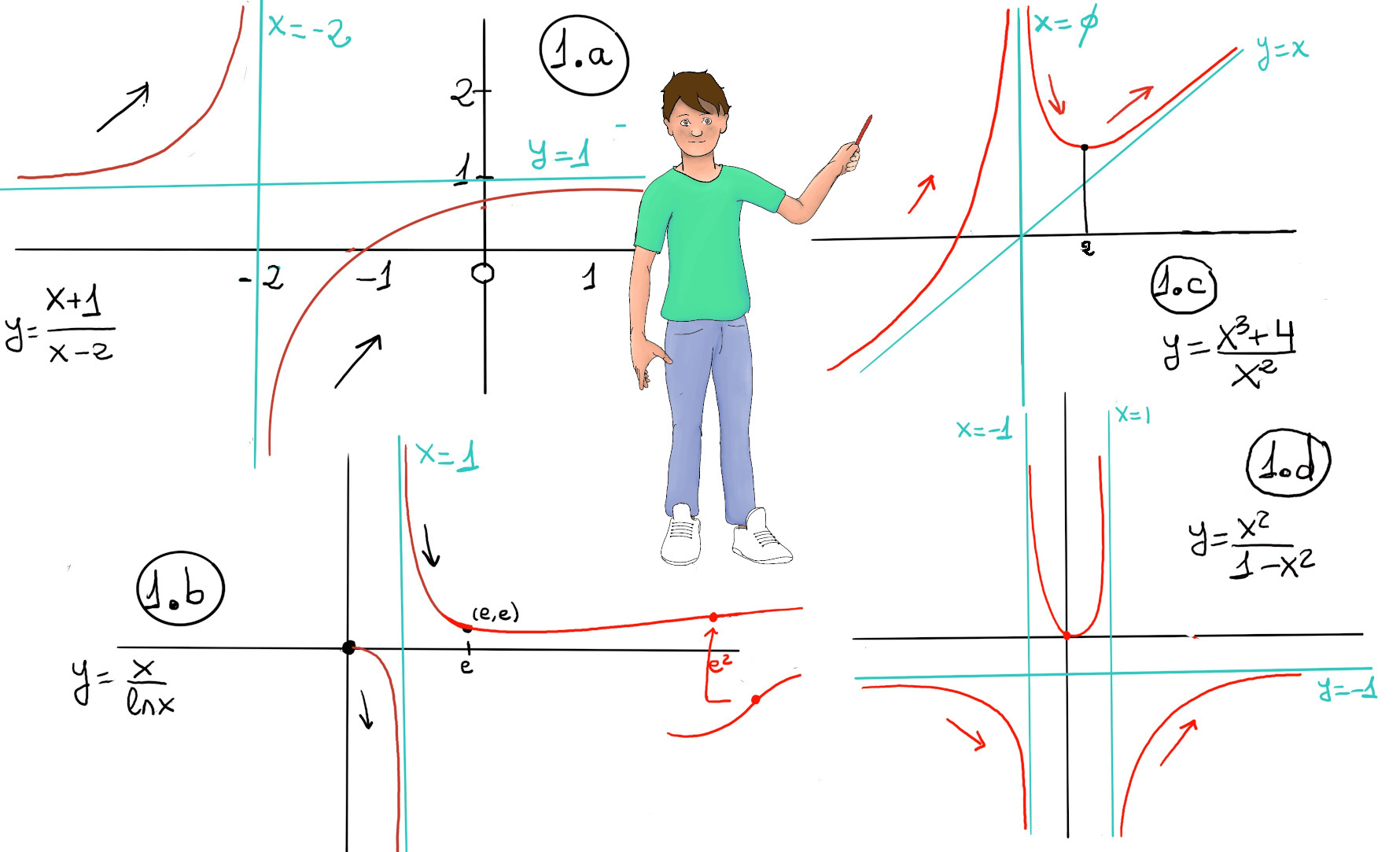
|
 |
 |
|
 |
Definition. A function f is a rule, relationship, or correspondence that assigns to each element of one set (x ∈ D), called the domain, exactly one element of a second set, called the range (y ∈ E).
The pair (x, y) is denoted as y = f(x). Typically, the sets D and E will be both the set of real numbers, ℝ.
Graphing functions involves the visual representation of a curve that reflects the behavior of a mathematical function on a coordinate plane, also known as the Cartesian plane. It is a two-dimensional space defined by two axes - the x-axis (horizontal) and the y-axis (vertical).
A systematic approach to graphing a function begins by constructing a table containing selected input values and their corresponding output values. By extending this table, we can plot the points on the coordinate plane and observe the pattern they form. Connecting these points reveals the shape of the curve, allowing us to gain insights into the behavior of the function across its domain. This process provides a visual means of understanding the relationships between different variables and aids in interpreting the overall characteristics of the function.
An asymptote is a horizontal, vertical, or slanted line such that the distance between the graph and the line approaches zero as one or both of the x or y coordinates tends to infinity. In other words, it is a line that the graph approaches (it gets closer and closer, but never quite reach) as it heads or goes to positive or negative infinity.
Vertical asymptotes are vertical lines (perpendicular to the x-axis) of the form x = a (where a is a constant) near which the function grows without bound. The line x = a is a vertical asymptote if: $\lim_{x \to a^{-}}f(x)=\pm\infty$ or $\lim_{x \to a^{+}}f(x)=\pm\infty$, e.g., x = -2 is a vertical asymptote of $\frac{x+1}{x+2}$.
$\lim_{x \to -2^{+}}\frac{x+1}{x+2} = \frac{-1}{0⁻} = \infty, \lim_{x \to -2^{-}}\frac{x+1}{x+2} = \frac{-1}{0⁺} = -\infty$
Horizontal asymptotes are a means of describing end behavior of functions and very closely related to limits at infinity. Horizontal asymptotes are horizontal lines (parallel to the x-axis) that the graph of the function approaches as x → ±∞. y = c is a horizontal asymptote if the function f(x) becomes arbitrarily close to c as long as x is sufficiently large or small or more formally: $\lim_{x \to \infty}f(x)=c$ and/or $\lim_{x \to -\infty}f(x)=c$, e.g., y = 1 is a horizontal asymptote of $\frac{x+1}{x+2}$ because $\lim_{x \to \pm\infty}\frac{x+1}{x+2} = 1$.
A polynomial is a function of the form f(x) = anxn + an-1xn−1 + … + a2x2 + a1x + a0. The degree of a polynomial is the highest power of x in its expression. Polynomial functions are defined and continuous on all real numbers. The degree and the leading coefficient of a polynomial determine the end behavior of its graph.

Definition. Rational functions are ratios of two polynomial functions, f(x) = $\frac{p(x)}{q(x)} = \frac{a_nx^n+a_{n−1}x^{n−1}+…+a_1x+a_0}{b_mx^m+b_{m−1}x^{m−1}+…+b_1x+b_0}$ where an ≠ 0, bm ≠ 0, and q(x) ≠ 0, e.g., $\frac{3-2x}{x-2}, \frac{x^3 + x^2 - 2x + 12}{x+3}.$
The limits at infinity for a rational function, say f(x) = $\frac{p(x)}{q(x)} = \frac{a_nx^n+a_{n−1}x^{n−1}+…+a_1x+a_0}{b_mx^m+b_{m−1}x^{m−1}+…+b_1x+b_0}$, can be exclusively determined or calculated based on its degrees (Limits of Rational Functions):
An exponential function is a mathematical function of the form f(x) = b·ax, where the independent variable is the exponent, and a and b are constants. a is called the base of the function and it should be a positive real number (a>0).
It is important to realize that as x approaches negative infinity, the results become very small but never actually attain zero, e.g., 2-5 ≈ 0.03125, 2-15 ≈ 0.00003052. Besides, the base of an exponential function determines the rate of growth or decay. For a > 1, the larger the base, the faster the function grows (Figure iii).


In mathematics, the logarithm is the inverse function to exponentiation. We call the inverse of ax the logarithmic function with base a, that is, logax=y ↔ ay=x, that means that the logarithm of a number x to the base a is the exponent to which a must be raised to produce x, e.g., log4(64) = 3 ↭ 43 = 64, log2(16) = 4 ↭ 24 = 16, log8(512) = 3 ↭ 83 = 512, but log2(-3) is undefined.
The logarithm’s domain consists of real positive numbers. Its range is ℝ (figure i and ii). x-intercept: (1, 0), y-intercept: none. It is one-to-one and has a vertical asymptote along the y-axis at x = 0.

The bigger the logarithm base, the graph approaches the asymptote of x = 0 quicker (Figure iii and iv).
Identify the asymptotes and end behavior of the following functions:
$ \frac{1}{x}$ (Figure i). $\lim_{x \to 0⁺} \frac{1}{x} = +∞, \lim_{x \to 0⁻} \frac{1}{x} = -∞$ ⇒ x = 0 is a vertical asymptote. $\lim_{x \to +∞} \frac{1}{x} = \lim_{x \to -∞} \frac{1}{x}= 0$ ⇒ y = 0 or the x-axis is a horizontal asymptote.
We don’t have an expression for (ii). There is a horizontal asymptote, y = 1. As x approaches positive and negative infinity, there is a horizontal asymptote, y = 1, even though the function clearly passes through this line an infinite number of times.

$\frac{x+1}{x+3}$ (Figure iii). $\lim_{x \to -3⁺} \frac{x+1}{x+3} = \frac{-2}{0⁻} = ∞, \lim_{x \to -3⁻} \frac{x+1}{x+3} = = \frac{-2}{0⁺} = -∞$ ⇒ x = 3 is a vertical asymptote. $\lim_{x \to +∞} \frac{x+1}{x+3} = \lim_{x \to -∞} \frac{x+1}{x+3}= 1$ ⇒ y = 1 is a horizontal asymptote.
$\frac{2x+1}{x^2-9}$ (Figure iv). $\lim_{x \to -3⁺} \frac{2x+1}{x^2-9} = \frac{-5}{0⁺} = -∞, \lim_{x \to -3⁻} \frac{2x+1}{x^2-9} = \frac{-5}{0⁻} = +∞$ ⇒ x = -3 is a vertical asymptote. Similarly, $\lim_{x \to 3⁺} \frac{2x+1}{x^2-9} = \frac{7}{0⁺} = +∞, \lim_{x \to 3⁻} \frac{2x+1}{x^2-9} = \frac{7}{0⁻} = -∞$ ⇒ x = 3 is a vertical asymptote, too.
$\lim_{x \to +∞} \frac{2x+1}{x^2-9} = \lim_{x \to -∞} \frac{2x+1}{x^2-9} = 0$ ⇒ y = 0 is a horizontal asymptote.

$\lim_{x \to -2⁺} \frac{x-2}{x^2-4} = \lim_{x \to -2⁺} \frac{1}{x+2} = \frac{1}{0⁺} = +∞, \lim_{x \to -2⁻} \frac{x-2}{x^2-4} = \lim_{x \to -2⁻} \frac{1}{x+2} = \frac{1}{0⁻} = -∞$ ⇒ x = -2 is a vertical asymptote.
$\lim_{x \to +∞} \frac{x-2}{x^2-4} = \lim_{x \to -∞} \frac{x-2}{x^2-4} = \lim_{x \to ±∞} \frac{1}{x+2} =0$ ⇒ y = 0 is a horizontal asymptote.
The plot is shown in Figure 1.d.

Domain = ℝ - {0}. f is not defined at x = 0.
$\lim_{x \to 0}\frac{x^{3}+4}{x^{2}} = \frac{4}{0^{+}} = \infty$, x = 0 is a vertical asymptote.
$\lim_{x \to \infty}\frac{x^{3}+4}{x^{2}} = \infty, \lim_{x \to -\infty}\frac{x^{3}+4}{x^{2}} = -\infty$.
When a linear asymptote is not parallel to the x- or y-axis, it is called an oblique asymptote. A function f(x) is asymptotic to y = mx + n (m ≠ 0) if: m = $\lim_{x \to \pm\infty} \frac{f(x)}{x} = m, \lim_{x \to \pm\infty} (f(x) -mx) = n.$
m = $\lim_{x \to \pm\infty}\frac{\frac{x^{3}+4}{x^{2}}}{x} = \lim_{x \to \pm\infty}\frac{x^{3}+4}{x^{3}}=1, lim_{x \to \pm\infty} \frac{x^{3}+4}{x^{2}} -x=lim_{x \to \pm\infty} \frac{4}{x^{2}} = 0,$ y =[m = 1, n = 0] x is an oblique asymptote, more details at this link. The plot is shown in Figure 1.c.